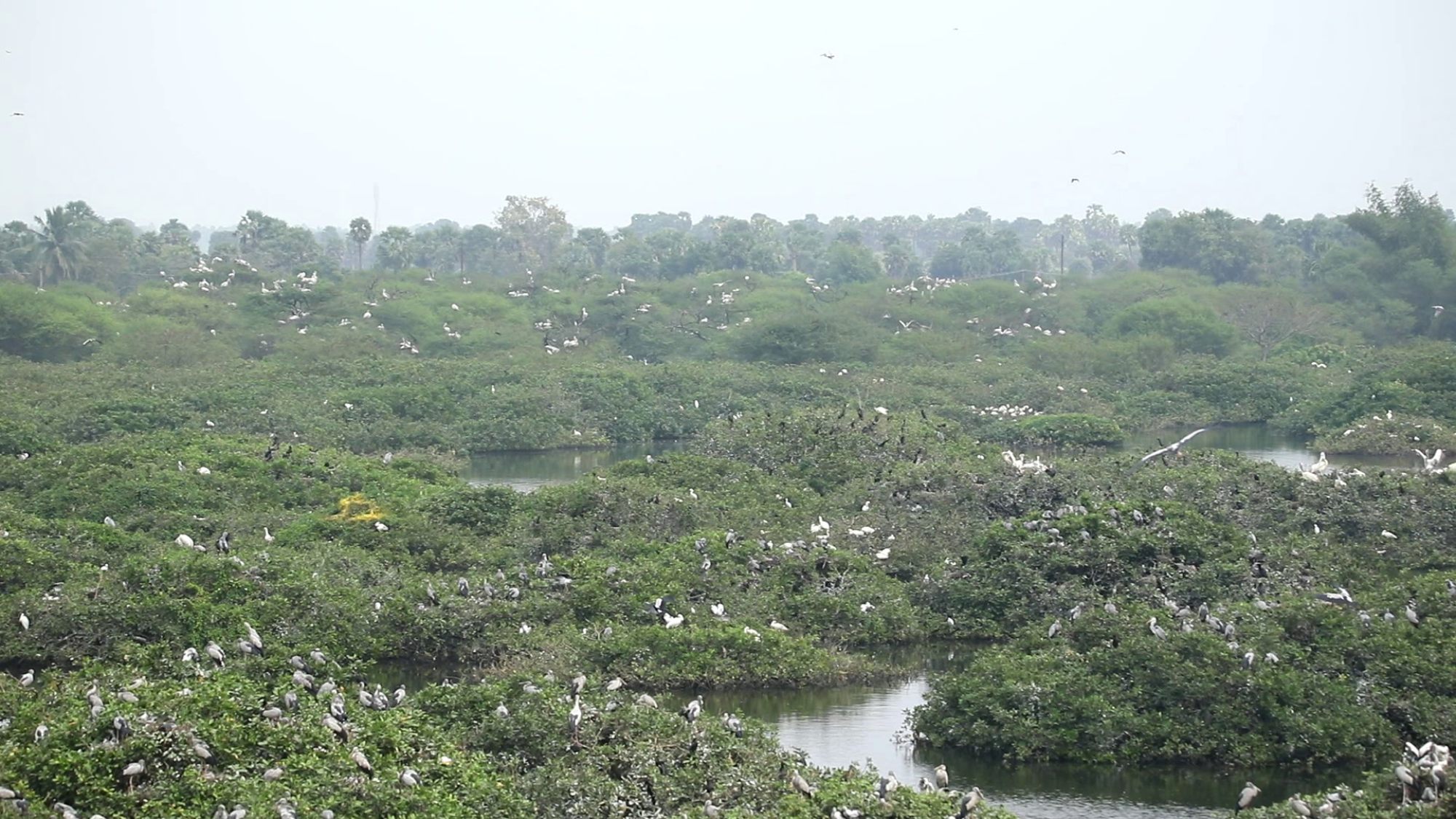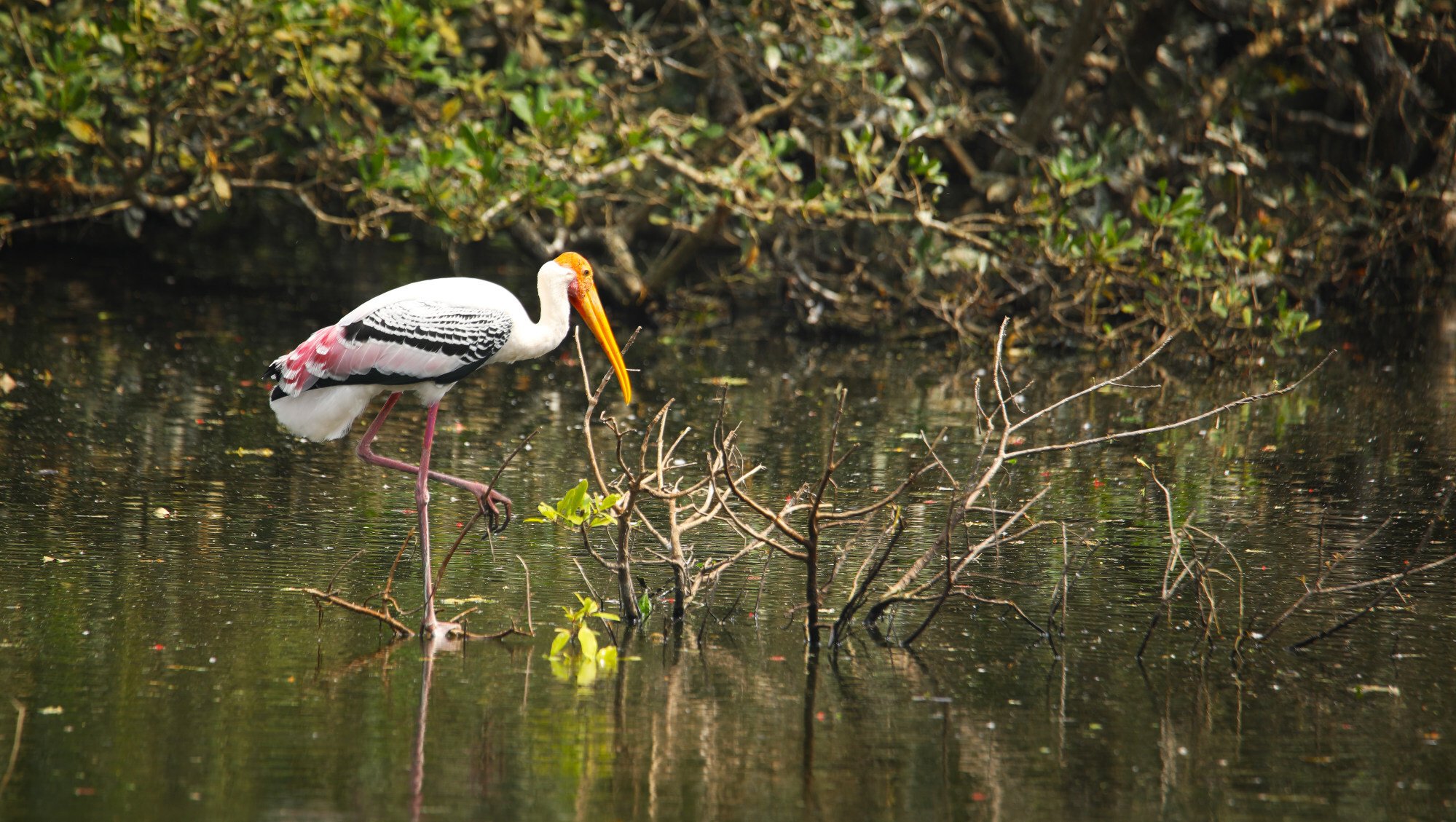
In India’s oldest avian sanctuary, Vedanthangal, a pollution-free vision turns toxic
- Vedanthangal, a tourist hotspot so beautiful it has inspired songs, is supposed to be protected from pollution. So why are trees wilting, animals dying, skin diseases appearing and farmers abandoning their land?
- Villagers have pointed the finger at a factory run by the pharmaceutical giant Sun Pharma
The core area of the sanctuary is about 30 hectares – the size of about 56 football fields – and is surrounded by the Pudupattu lake, which links to smaller bodies of water that flow around grassy mud islands that are home to lush shrubs, paddy fields and trees with large canopies.
Vedanthangal has been a protected reserve since the start of the 19th century but in 1998, it was officially designated a “wildlife sanctuary”, restricting human activity in the area. While the creation of villages and farming were still allowed – the birds’ nitrogen-rich droppings made for good harvests in the paddy fields – pollution-causing industries were prohibited and new commercial activities such as manufacturing and mining were not allowed within 5km of the lake.

The sanctuary is a tourist hotspot and a popular destination for school trips and nature lovers. Species like the grey wagtail, blue-winged teal, sandpiper, pintail, garganey – many of which are native to the European continent – and a host of other local birds have been found there. So famous has the sanctuary become that songs in films often tell of its beauty and birds.
New Delhi’s smog towers: experts say they’re full of hot air
A study conducted by a group of activists last year found traces of four industrial solvents – dibromochloromethane, dichloromethane, tetrachloroethene and toluene, all of which are commonly used in pharmaceutical manufacturing – in the nearby soil and water bodies.
Last July, the southern bench of the National Green Tribunal, India’s main environmental court, appointed an expert panel of local government officials to investigate whether Sun Pharma was following proper pollution control measures. The nine-member panel has collected soil and water samples from the region for investigation but has not submitted its report despite its initial two-month deadline having been extended twice. The panel, which is due to make an appearance in court on April 30, said its initial investigations had not found any wrongdoing with Sun Pharma’s paperwork but final investigation results with the tests of soil and water samples were still pending.
‘COMMITTED TO THE ENVIRONMENT’
When asked about the alleged discharge of effluents, MA Joy, the Sun Pharma facility’s general manager, said the claims “may or may not be right”.
He pointed out there were other industrial set-ups near the sanctuary as well and denied that Sun Pharma was the main culprit.
Among the other industrial establishments operating within the sanctuary’s 5km zone is a battery-manufacturing unit, also built before 1998.
Sun Pharma is India’s largest drug maker and has a market cap of US$15 billion, according to Forbes. It manufactures a variety of pharmaceutical products that are used in diabetology, neurology, cardiology, and psychiatry.

Asked to respond to the allegations, a Sun Pharma spokesman from its corporate headquarters in Mumbai said by email in early March that the plant adhered to government regulations and was “committed to ensuring a clean and healthy environment around our plant”.
“Sun Pharma’s plant at Sathammai village, Maduranthakam, has a Zero Liquid Discharge system with a state-of-the-art waste treatment facility. We also have a solvent recovery plant at the premises for recycling of solvents,” the spokesman said.
Despite those assurances, villagers fear pollution near the sanctuary could be about to get worse. From March 2020 to January this year, the sanctuary was shut to visitors due to the Covid-19 pandemic. During this time, at the peak of the pandemic in June last year, Sun Pharma sought clearance from the Tamil Nadu state government to nearly triple its production capacity.
While that proposal was rejected, the government has instead proposed to reduce the 5km radius around the sanctuary to 3km – which would mean Sun Pharma’s unit will be free to expand its production capacity significantly.
Birds and animals cannot live. The entire ecosystem is severely affected
NEED FOR STRINGENT RULES
Interviews with at least 40 villagers, shopkeepers, farmers, ornithologists and environmental activists, done over the course of several trips to the Sun Pharma plant in Sathammai village and half a dozen neighbouring villages, showed widespread worry and anger about the situation.
Several farmers told This Week in Asia they had abandoned cultivation in over 400 hectares of arable lands – sandwiched between the pharmaceutical plant and the sanctuary’s core – since the factory was built.
Vijay Kumar, who formerly headed the council of Vellaputhur village, said residents had developed skin diseases and some had moved away.
“Fishing in Pudupattu lake has stopped,” Kumar said. “Birds and animals cannot live. The entire ecosystem is severely affected [due to the pharmaceutical plant].”
Narayanasamy, 63, a farmer whose forefathers have lived in the area for centuries, said the fields were no longer fertile.
“Black plum [Jamun] trees, about 70 to 80 years old, which once dotted the area, have gradually rotted and disappeared,” he said.
A vendor who sells tender coconut just outside the sanctuary said people identifying themselves as Sun Pharma representatives would mill around during local festivals and give anywhere between 100,000 to 500,000 rupees (US$1,300 to US$6,600) to local politicians, community leaders and villagers or promise them employment to keep locals on their side so that complaints did not reach higher government authorities. At least three other shopkeepers echoed these allegations but they declined to be identified due to fear of repercussions.
Asked about the bribery allegations, the factory’s general manager MA Joy declined to comment. This Week in Asia is waiting for a response from Sun Pharma’s corporate headquarters about the bribery claims.

“Sun Pharma’s industry is pollution-intensive, in terms of water and air. [The plant] is categorised as a red-category large hazardous industry. Such industries are known to cause pollution. Efforts have to be taken to manage it,” said Nityanand Jayaraman, an environmental researcher who runs the non-profit organisation Vettiver Collective.
Jayaraman urged the pollution control board of the state government to ensure the company was not violating the law.
He and other activists have called for more stringent rules to ensure that industries in the area do not discharge untreated waste to the sanctuary’s lakes or require them to relocate.
Delhi, where even China’s pollution fades into insignificance
G Subbaiah, the Tamil Nadu state government’s Sanctuary Range Officer in charge of the sanctuary, said it was true that the birds’ feeding ground had been shrinking over the years. However, it was hard to verify the villagers allegations.
“If there are companies, they will erect a compound wall and we will not know what they do inside. Since these are private properties we cannot interfere and check much,” said Subbaiah, who is not a member of the expert panel but was involved in its investigation.
Dr V Santharam, a renowned ornithologist who has written extensively on Vedanthangal’s wetland birds, said it was not enough to just call Vedanthangal a protected sanctuary. He said local authorities needed to go beyond clamping down on violations by ensuring the entire sanctuary was free of polluting industries.
“Otherwise, it is quite likely that the birds may abandon the nesting sites forever. And that will be a shame.”
This story was produced with the support of Internews’ Earth Journalism Network

